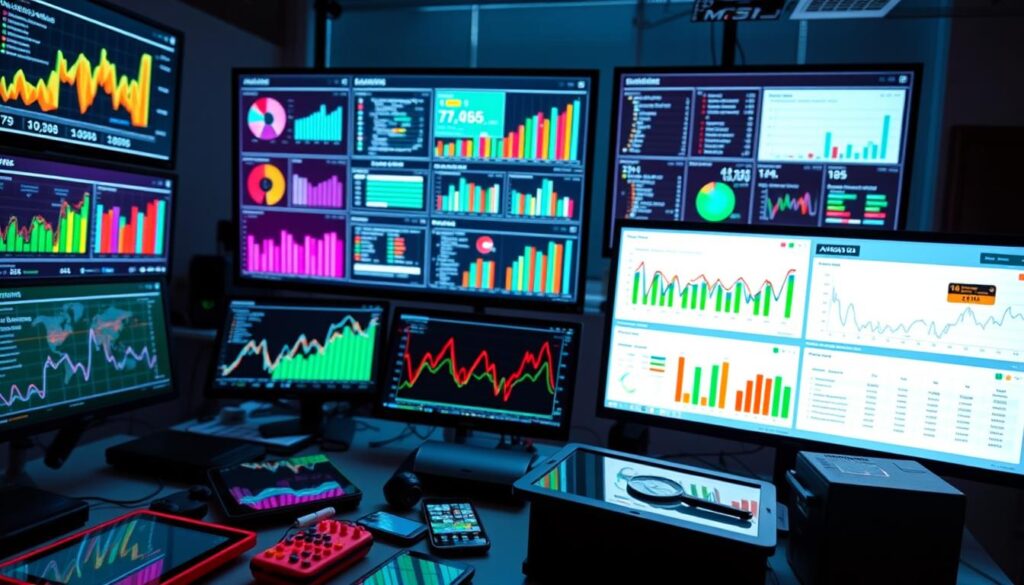In today’s digital world, businesses need to keep up with their ad investments. The digital ad world is always changing. Marketers have many tools and platforms to track, analyze, and improve their campaigns. This guide will cover 9 key tools for better digital ad performance in 2024.
Key Takeaways
- Discover 9 must-have tools to track and optimize digital ad performance in 2024
- Understand the importance of comprehensive digital ad performance tracking
- Explore programmatic advertising platforms and audience targeting tools
- Learn about ad creative testing and optimization strategies
- Dive into cross-channel attribution models and conversion tracking
- Measure ad spend ROI and leverage AI for performance insights
- Stay ahead of the curve with emerging trends in digital ad performance tracking
The Importance of Tracking Digital Ad Performance
In today’s fast-changing digital world, tracking your marketing campaigns is key for businesses. It helps them use their ad money wisely and get better results. By using the right tools and analytics, marketers can learn a lot about how well their ads work.
Knowing how well ads perform helps businesses make smart choices. They can use their resources better, which means a higher return on investment (ROI). This leads to a more successful marketing plan.
Tracking ads shows which ones connect with the audience and where they can get better. This info lets marketers tweak their messages and target better. It helps them spend their ad money smarter, leading to better results and more effective campaigns.
“Accurate tracking of digital ad performance is the cornerstone of any successful marketing strategy in today’s data-driven landscape.”
With the right tools and analytics, businesses can learn a lot about what their audience likes and how their marketing affects them. This info helps them improve their targeting and ad creativity. It also helps them make smarter choices about their marketing strategy.

In conclusion, tracking digital ad performance is very important. It’s a key part of a successful marketing plan. It helps businesses make the most of their ad spending, improve their campaigns, and get better results and a higher return on investment.
Programmatic Advertising Tools for Optimal Targeting
In the digital advertising world, programmatic platforms and real-time bidding (RTB) have changed how businesses target their audience. These tools use advanced algorithms and data to automate ad buying. This means ads get shown to the right people at the right time.
Real-Time Bidding Platforms
RTB platforms let advertisers bid on ad spots in real-time. This makes targeting more precise and efficient. They look at lots of user data to find the best impressions. This helps businesses make their programmatic advertising campaigns hit the mark.
Audience Segmentation and Targeting Tools
Audience segmentation and targeting tools add to the programmatic ad buying process. They help marketers make campaigns that really speak to people. By using data analytics, businesses can segment their audience well. This way, they can send messages that really connect with their customers.
| Programmatic Advertising Tool | Key Benefits |
|---|---|
| Real-Time Bidding Platforms |
|
| Audience Segmentation and Targeting Tools |
|
Using these programmatic advertising tools, businesses can make the most of their digital marketing. This leads to more engagement, conversions, and success.

“Programmatic advertising is the future of digital marketing. It allows us to reach our target audience with unprecedented precision and efficiency.”
Ad Creative Testing and Optimization
Crafting digital ads that grab your audience’s attention is key. But, the real magic happens with ad creative testing and optimization. By trying out different ad formats, copy, images, and calls-to-action, businesses can find what works best for their customers.
A/B testing is a great way to do this. It lets marketers test two or more ad versions at once. This way, they can see which ads get the most attention and make smart choices to improve their campaigns.
Dynamic creative optimization (DCO) takes it even further. DCO changes ads on the fly based on who’s looking at them. It makes ads more relevant to each person, making every ad more impactful.
By using ad creative testing and optimization wisely, businesses can make the most of their ads. They can keep trying new things and making their ads better. This leads to more people getting involved, more sales, and a better return on their investment.
“Continuous testing and optimization of ad creatives is the key to unlocking the true power of digital advertising.”
Cross-Channel Attribution and Conversion Tracking
In the digital marketing world, it’s key to know how well ad campaigns work. This is where cross-channel attribution and conversion tracking help. They give marketers a clear view of how customers move through the buying process. This helps them make smart choices that lead to better results.
Multi-Touch Attribution Models
Old ways of tracking often miss the full effect of marketing efforts. Multi-touch attribution models look at how customers interact with ads at different stages. They see how each touchpoint helps lead to a sale. This way, marketers can spend their ad money better and fine-tune their strategies across channels.
Conversion Tracking and Analytics
Conversion tracking and analytics give deep insights into how ads perform. They help businesses see the real effect of their digital ads. They track how customers move from being aware of a product to making a purchase. This helps marketers improve their marketing analytics and spend their ad budget wisely.
“Comprehensive cross-channel attribution and conversion tracking are essential for modern marketers to understand the true impact of their digital advertising efforts.”
Using these advanced tools, businesses can make choices based on data. This leads to better digital ad performance and growth that lasts.
Ad Spend ROI Measurement Tools
It’s key for businesses to measure the ROI of their digital ads. This helps them justify their marketing budgets and make smart choices about where to spend more. Ad spend ROI tools help marketers see how much revenue and leads their ads bring in. This lets them find the best ways to grow their business.
These tools give a full view of how ads are doing. Marketers can track things like click-through rates and cost-per-acquisition. By looking at this data, businesses can fine-tune their ad campaign optimization. This way, they can boost their marketing roi and ad spend roi.
Some top ad spend ROI tools are:
- Google Analytics: Gives deep insights into website traffic and how ads perform.
- Facebook Ads Manager: Tracks ROI of Facebook and Instagram ads, including reach and conversions.
- Bing Ads: Offers detailed reports on ad campaigns on Bing, like cost-per-click and conversions.
- Adobe Analytics: A platform that helps businesses see how their ads affect multiple channels.
| Tool | Key Features | Pricing |
|---|---|---|
| Google Analytics |
|
Free |
| Facebook Ads Manager |
|
Free |
| Bing Ads |
|
Varies based on ad spend |
| Adobe Analytics |
|
Subscription-based pricing |
Using these ad spend ROI tools, businesses can make their digital ads better. They can improve how their campaigns do and get more from their investment.
Digital Ad Performance Tracking with Ad Fraud Detection
In the fast-paced world of digital ads, ad fraud is a big problem. It can hurt how well campaigns do and the return on investment (ROI). To fight this, tools for detecting ad fraud are now key for tracking digital ad performance.
These tools use smart algorithms and data analysis to spot and stop fraud. This includes things like bot traffic, fake clicks, and wrong data on impressions. By using these tools, businesses can make sure their data is right and improve their campaigns.
- Ad fraud detection tools use machine learning to look at lots of ad data. They find patterns that show fraud.
- These tools watch in real-time and spot odd activities fast. This lets marketers act quickly to save their ad money.
- They also have advanced ways to figure out where conversions come from and how well campaigns work. This helps businesses see the real effect of their ad campaign optimization efforts.
With ad fraud detection, businesses can trust their digital ad performance data more. This helps them make better choices and get better results from their ads.
“Integrating ad fraud detection into digital ad performance tracking is essential for maintaining the integrity of campaign data and optimizing marketing ROI.”
The digital ad world is always changing. Being able to spot and stop ad fraud is key for businesses to make the most of their ad campaign optimization efforts.
Comprehensive Digital Ad Performance Dashboards
Putting all digital ad data into one dashboard is key for businesses. It gives a full view of their marketing work. These dashboards use powerful tools for data visualization and let marketers track KPIs. This helps them spot trends, analyze data, and make smart choices to boost their ads.
Data Visualization and Reporting
These digital ad performance dashboards bring together metrics from different digital channels. They offer a clear view of how well ads are doing. With tools like interactive charts and graphs, marketers can easily understand and share complex marketing analytics with others.
Customizable KPI Tracking
Being able to pick what KPIs to track in the digital ad performance dashboard changes the game for marketing teams. They can focus on what’s most important to their business, like click-through rates or return on ad spend. This flexibility helps marketers make smart, data-based choices to improve their digital ad performance.
| Feature | Benefit |
|---|---|
| Data Visualization | Easily interpret complex marketing analytics and communicate insights to stakeholders |
| Customizable KPI Tracking | Track the specific metrics that matter most to your business and optimize digital ad performance |
| Consolidated Performance Metrics | Gain a holistic view of marketing efforts and make data-driven decisions |
Integrating Digital Ad Performance with Marketing Automation
In the digital marketing world, combining ad performance tracking with marketing automation is key. This combo helps businesses optimize campaigns and engage customers better. By linking these tools, companies can make their work flow smoother, tailor content, and boost conversion rates.
Marketing automation lets marketers automate tasks like lead nurturing and email campaigns. When it’s linked with ad performance data, the potential for better optimization and personalization grows a lot. Now, marketers can set off targeted ads, customize content, and guide leads with insights from their ad campaigns.
This combo helps businesses to:
- Automatically adjust ad budgets and targeting based on performance data
- Personalize marketing messages and offers based on customer interactions with ads
- Retarget and re-engage customers who have interacted with ads but not converted
- Streamline the entire ad campaign optimization process by leveraging automated workflows
Using marketing automation and ad performance tracking, businesses can give customers more relevant and personal experiences. This leads to better engagement, more conversions, and keeping customers around longer.
| Benefits of Integrating Digital Ad Performance with Marketing Automation | Impact on Business |
|---|---|
| Automated ad budget allocation and targeting adjustments | Improved ad campaign efficiency and ROI |
| Personalized marketing messages and offers | Higher customer engagement and conversion rates |
| Retargeting and re-engagement of customers | Increased customer retention and loyalty |
| Streamlined ad campaign optimization workflows | Reduced manual effort and improved productivity |
By using the power of digital ad performance and marketing automation, businesses can create a strong system. This system makes advertising more effective and efficient, leading to success in digital marketing.
Leveraging AI and Machine Learning for Digital Ad Performance
The digital ad world is changing fast thanks to AI and machine learning. These tools are changing how we track and improve digital ad performance.
AI can look at huge amounts of data, find patterns, and change ad campaigns in real time. This means better efficiency and a higher return on investment (ROI). AI and machine learning are changing how we measure and boost digital ad performance.
Using AI and machine learning in ads lets us make campaigns more personal and efficient. They can look at lots of data, like what users do, who they are, and what they like. This helps make ads that are just right for each person.
AI also helps with ad campaign optimization. It can change bids, budgets, and where ads show up based on how well they’re doing. This means ads spend is used where it does the most good, improving digital ad performance and ROI.
As ads move more online, using AI and machine learning will be key for businesses to stay ahead. By using these new tools, marketers can get better insights, optimize campaigns, and see big wins in digital ad performance.
Emerging Trends and Future of Digital Ad Performance Tracking
The digital ad world is always changing, bringing new trends and tech to the table. Marketers need to keep up with these changes to make the most of their strategies. They should use the right tools to get great results.
Now, more ads are using first-party data. This is because third-party cookies are fading out. Companies are now using their own customer data for better targeting and personalization. This means they need better data management and analytics to get useful insights.
Another big trend is privacy-focused advertising. People care more about their data privacy, and laws are getting stricter. Marketers must use privacy-preserving techniques. This includes contextual targeting and machine learning for attribution, to meet these new rules and still perform well.
Using advanced analytics and attribution models is also changing how we track ad performance. New data visualization tools and customizable KPI dashboards will help marketers understand their campaigns better. This will let them make smarter choices.
The ad industry trends are pointing towards a future where data-driven strategies, personalized experiences, and privacy-centric approaches are key. By keeping up with these trends, businesses can improve their digital ad performance. This will help them stay ahead in the fast-changing digital world.
Conclusion
In today’s fast-paced digital world, tracking and improving ad performance is key for businesses. This guide highlights 9 essential tools to help marketers. These tools offer valuable insights, better audience targeting, and ways to boost digital ad campaigns.
Tools like programmatic advertising and AI analytics help businesses make smart decisions. They keep up with trends and make their marketing strategies stronger. By using the latest in digital ad tracking, companies can stand out and run more effective campaigns.
This guide is great for both experienced marketers and newcomers to digital ads. It shows how to measure and improve ad performance. With these advanced tools, businesses can find new chances for growth and succeed in the changing digital world.
